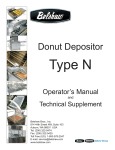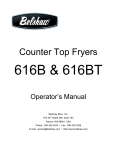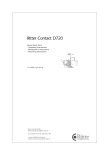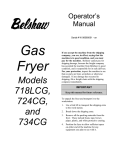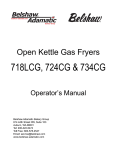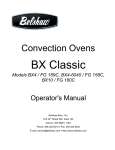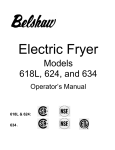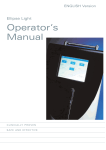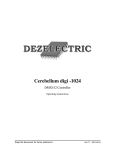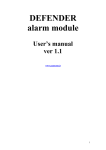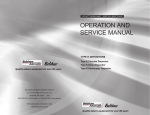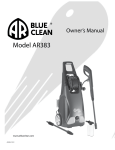Download Belshaw Brothers 616BT Operator`s manual
Transcript
Counter Top Fryers Models 616B & 616BT Operator’s Manual Belshaw Bros., Inc. 1750 22nd Avenue South Seattle, WA 98144 Phone: 206-322-5474 • Fax: 206-322-5425 Toll Free: 1-800-578-2547 E-mail: [email protected] • http://www.belshaw.com To unpack the fryer and transport it to the workstation: If you accept the machine from the shipping company, you are, in effect, saying that the machine is in good condition, and you must pay for the machine. Belshaw cannot pay for shipping damage, because the freight company has accepted the machine from Belshaw in good condition, and is responsible for its safe delivery. For your protection, inspect the machine to see that no parts are bent, scratched, or otherwise damaged. If any damage has occurred in shipping, file a freight claim with the shipping company immediately. 1. Use a fork lift to transport the shipping crate to the work station. 2. Break down the shipping crate. 3. Remove all the packing materials from the fryer. These include foam, tape, brown paper, plastic, and white protective coating. 4. Position the fryer to allow sufficient space on either end of the machine for any equipment you plan to use with it. IMPORTANT Keep this manual for future reference. EQUIPMENT RECORD Please provide the information below when you correspond with us about your machine. Purchased by _____________________________________________________________________ Installed by ______________________________________________________________________ Date of Installation ________________________________________________________________ Model number ___________________________________________________________________ Serial number 0204 MN-1136EN Belshaw Bros., Inc. 1750 22nd Avenue South Seattle, WA 98144-4590 USA Phone: (206) 322-5474 • Fax: (206) 322-5425 Toll Free: (800) 578-2547 Email: [email protected] • http://www.belshaw.com Contents Sections 1 Installation 1 Unpacking the Fryer Initial Cleaning Installing the Fryer Moving the Fryer 1 1 1 2 2 Operation 3 3 Cleaning 5 Cleaning the Exterior Surfaces Cleaning the Frying Screen Cleaning the Kettle Removing the Shortening Washing 5 5 5 5 6 4 7 Calibrating The Fryer Appendixes A Donut-Making Helps 8 Tips on Making Quality Cake Donuts Calculating Correct Water Temperature Ratios of Plunger Sizes to Donut Weights Temperature Conversion 8 9 9 9 B Electrical Components 10 Testing the Continuity of the Toggle Switch Testing the Continuity of the Thermostat 10 11 C Parts Lists 14 D Wiring Diagrams 17 Limited Warranty Insert Belshaw Bros., Inc. • 1750 22nd Ave. S. • Seattle, WA 98144 • Phone 206-322-5474 • Fax 206-322-5425 616B & 616BT Counter Top Fryer MN-1136EN iii Preface The 616B and 616BT donut fryers have been designed and built using the finest materials and components available. It is the result of years of research and development. Designed into this unit are many features which will insure more quality in your products and reduce your operating cost. Attention to the instructions regarding installation, operation, and maintenance should result in years of troublefree service. The operator must work safely at all times and read this manual and follow its instructions and warnings. A thorough understanding of how to install, maintain, and safely operate the fryer will prevent production delays and injuries. Heed the following warnings and all other warnings that appear in this manual: • Hot shortening can cause serious burns. Make sure that the system and the shortening are cool before attempting any cleaning, adjustment, disassembly, or repair. • To avoid electrocution or other injury, unplug the machine before attempting any cleaning, adjustment, disassembly, or repair. • Be careful never to get shortening, water, or other materials on the floor. If anything does get spilled on the floor, mop it up immediately. Materials on the floor can cause people to slip or fall, resulting in serious injury or loss of life. • To prevent unintentional startup and possible fire, unplug the machine if there is a local power outage. When the power is restored, it is safe to plug the machine in again. • To avoid damaging the machine, never use force to assemble, disassemble, operate, clean, or maintain it. • Never let water and hot shortening come in contact with each other. Moisture causes hot shortening to spatter, which may cause serious burns. • To avoid electrocution, make sure that all electrical cords are not frayed or cracked and that they do not pass through any water or shortening. • Do not overfill the kettle with shortening. If shortening overflows the kettle, it could cause serious burns or could cause someone to slip on the floor and be seriously injured. • Make sure that all electrical cords are routed so that no one will trip over them. Belshaw Bros., Inc. • 1750 22nd Ave. S. • Seattle, WA 98144 • Phone 206-322-5474 • Fax 206-322-5425 iv MN-1136EN 616B & 616BT Counter Top Fryer 1 Installation Unpacking the Fryer 1. Use a fork lift to transport the shipping crate to the work station. WARNING Never let water and hot shortening come in contact with each other. Moisture causes hot shortening to spatter, which may cause serious injury. Prior to use, make sure the kettle and any other parts you have washed are dry. 2. Break down the shipping crate. 3. Remove all the packing materials from the fryer. These include foam, tape, brown paper, plastic, and white protective coating. 4. Check the fryer carefully for any damage that may have occurred during shipping. File any claims with the shipping company. Installing the Fryer Position the fryer to allow sufficient space on either end of the machine for any equipment you plan to use with it. 1. Make sure the power requirements of the machine, found on the data/name plate, match your power source. 5. Initial Cleaning Clean your fryer before using it. Wipe the inside of the kettle with a soft, damp cloth. Dry the kettle thoroughly. WARNING To avoid electrocuting yourself or damaging the machine, never allow water, steam, cleaning solution, or other liquid to enter the heater head or the electrical box. 2. Set the fryer cabinet on a flat, dry counter or table. 3. Level the fryer. 4. Connect the fryer to a properly grounded power source. Do not turn on the power. 5. When first filling the kettle with shortening, if a hydrogenated or semi-solid shortening is used, melt some shortening and pour it into the kettle. 6. Cover the elements, thermostat bulb and high temperature limit control bulb with shortening before turning on the power. WARNING Do not turn the thermostat above 250°F until all the shortening has melted. 7. Due to the delicate mechanism of the thermostat, it is possible for it to get out of adjustment. If this occurs, recalibrate per the instructions in section 4. Belshaw Bros., Inc. • 1750 22nd Ave. S. • Seattle, WA 98144 • Phone 206-322-5474 • Fax 206-322-5425 616B & 616BT Counter Top Fryer MN-1136EN 1 8. The heater head assembly is equipped with a high temperature limit control. Push the reset button on the back of the heater head if power to the heater elements is cut off. 6. Level the fryer and connect it to the power source, as explained in “Installing the Fryer” above. 9. When heating shortening that has solidified, a pocket of shortening may overheat and cause the high temperature limit control to cut power to the elements. Push the reset button to resume heating. Moving the Fryer If you ever want to move the fryer to a different workstation, follow this procedure: 1. Turn off the fryer and disconnect it from the power source. 2. Allow the machine and the shortening to cool. WARNING Do not touch hot shortening. It can cause serious burns. 3. Remove the shortening from the fryer as explained in “Removing the Shortening” in Section 3. WARNING To avoid burns, falls, other injury, or death, never attempt to move the fryer when it has shortening or other liquid in it. WARNING Thoroughly clean and dry the floor if shortening is spilled. Materials on the floor can cause people to slip or fall, resulting in serious injury or loss of life. Belshaw Bros., Inc. • 1750 22nd Ave. S. • Seattle, WA 98144 • Phone 206-322-5474 • Fax 206-322-5425 2 MN-1136EN 616B & 616BT Counter Top Fryer 2 Operation Read each step completely before doing what it tells you to do. • Melt shortening in a pan on the stove and pour it into the kettle. 1. • Very carefully put solid shortening into the kettle. Put enough shortening in the kettle to completely cover the heating elements, thermocouple, and high-temperature limit control probe. WARNING Put shortening in the kettle using one of these methods: To avoid serious burns, be very careful not to splatter hot shortening when you add shortening to the kettle. WARNING Hot shortening causes severe burns. • Melt shortening in a pan on the stove and pour it into the kettle. • Put solid shortening into the kettle, packing it tightly around the heating elements, thermocouple, and hightemperature limit control probe. Because shortening expands as it increases in temperature, put shortening in the kettle gradually. Let the shortening in the kettle heat up before you add more. 5. The “Heating” pilot light will go out if the high temperature limit control breaks the circuit. WARNING Air spaces can cause the shortening to overheat and catch on fire. 2. 3. 4. Note: If the high temperature limit control does break the circuit, push the red reset button on the back of the heater head. 6. Turn on the unit by turning the thermostat clockwise 1/16 turn. When the unit is turned on, the power light located next to the thermostat knob will be lit. Set the thermostat to 250°F/121°C. The “Heating” pilot light above the elements will light up, indicating that the shortening has not yet reached the selected temperature. Continue adding shortening to the kettle until it reaches the “Oil Level” marks on the kettle. Use one of the following methods. After all of the shortening has melted, set the thermostat to the desired frying temperature. Wait for the shortening to reach the desired temperature. WARNING To avoid serious burns, when the fryer is operating, do not touch any part of the fryer that is in contact with hot shortening. 7. If you are frying cake or French donuts, move the cutter into place over the fryer. Refer to the cutter manual (Type N cutter) for complete installation and operation instructions. Belshaw Bros., Inc. • 1750 22nd Ave. S. • Seattle, WA 98144 • Phone 206-322-5474 • Fax 206-322-5425 616B & 616BT Counter Top Fryer MN-1136EN 3 To fry yeast-raised donuts, place donuts on the fry screen and slowly lower the screen into the fryer. With the donut stick, turn the donuts over to fry the top side. Remove the fry screen and donuts when the donuts are completely fried by lifting up the fry screen with the donuts on top of it. Immediately place on or over a tray to catch dripping shortening. WARNING Hot shortening will drip off the fry screens, causing a slip hazard. To avoid serious injury or loss of life, be very careful and immediately clean up any drips. WARNING To avoid serious burns, be careful of hot shortening dripping from the fry screens. Do not touch hot shortening and immediately clean up spills and drips. 8. Continue supplying shortening to the kettle as required. Keep the kettle filled up to the “Oil Level” marks on the side. 9. When you are done frying donuts, move the thermostat knob counter-clockwise as far as it will go. Frying Tips 1. Use a high quality hydrogenated shortening. 2. Store your supply of cooking shortening at room temperature. 3. To prolong the life of the shortening, do not keep shortening at high temperature if the fryer is not being used. 4. Drain and strain shortening periodically. Several layers of cheesecloth will do a good job of filtering. 5. Keep the fryer and screens clean. 6. Maintain shortening at the proper level in the fryer. Add fresh shortening to keep the level at the “Oil Level” marks stamped on the kettle sides. 7. Add at least 15% fresh shortening to your kettle daily. 8. Discard shortening as soon as it tends to bubble or foam during frying. 9. At least once a day, cool a small sample of shortening from the fryer and taste it to see if it has picked up a foreign or rancid taste. Belshaw Bros., Inc. • 1750 22nd Ave. S. • Seattle, WA 98144 • Phone 206-322-5474 • Fax 206-322-5425 4 MN-1136EN 616B & 616BT Counter Top Fryer Cleaning For your safety, observe the following warnings throughout the entire cleaning process. 3 Cleaning the Frying Screen 1. In a sink or a dishwasher, wash the frying screen using warm water and mild detergent. Do not use an abrasive cleaner or scraper. 2. Rinse the frying screen in clear water. 3. Dry the frying screen thoroughly, using a soft cloth, before you use it again. WARNING Thoroughly clean and dry the floor if shortening, water, or other materials are spilled. Materials spilled on the floor can cause serious injury or loss of life. WARNING WARNING To avoid electrocuting yourself or damaging the machine, never allow water, steam, shortening, cleaning solution, or any other liquid to enter the electrical box or the heater head. WARNING To avoid being burned in an explosion, never use any flammable materials for cleaning. Cleaning the Exterior Surfaces 1. 2. Clean the polished and painted surfaces of the fryer with a soft, damp cloth. Use a nonabrasive cleaner to remove any discoloration. Polish these surfaces with a soft, dry cloth. Dry the frying screen thoroughly. Moisture causes hot shortening to spatter, which may cause serious injury. 4. Check the frying screen to make sure no metal is flaking off of it. If the screen is flaking, replace it immediately, so you do not get metal particles in your product. Cleaning the Kettle Removing the Shortening WARNING To avoid being burned or electrocuted, disconnect the fryer from the power source before cleaning it. 1. Disconnect the machine from the power source. 2. Let the shortening cool to 100°F/38°C. 3. Carefully dip out the shortening into a suitable container. Do not disturb the accumulated sediment in the bottom of the kettle. Belshaw Bros., Inc. • 1750 22nd Ave. S. • Seattle, WA 98144 • Phone 206-322-5474 • Fax 206-322-5425 616B & 616BT Counter Top Fryer MN-1136EN 5 WARNING Do not use a plastic container. If the shortening is not cool enough, the container will melt, possibly causing you to be burned, and causing shortening spill. Washing 1. Wash the kettle carefully with detergent to remove all stains and burned shortening. 2. Scrub the inside of the kettle. Do not use any abrasive cleaners or scrapers. WARNING WARNING Do not allow the shortening to overflow the containers. Shortening will get on the floor, and if the shortening is not cool enough, you may be burned. 4. After the kettle has been drained, brush any accumulated carbon from the heater coils. Accumulated carbon causes corrosion and poor heat recovery. 5. Remove the drain tray. WARNING Thoroughly clean and dry the floor if shortening is spilled. Shortening on the floor can cause serious injury or loss of life. To avoid being burned, be very careful as you work with hot cleaning solution. Never put your hands in the solution. Wear gloves and long sleeves in case any solution splashes. 3. Dry the kettle thoroughly with a soft cloth before replacing in the fryer cabinet. WARNING Dry the kettle thoroughly. Moisture causes hot shortening to spatter, which may cause serious injury. 4. Make sure the kettle is properly seated in the case. 5. Install the heater head. 6. Remove the heater head and element. 7. Lift out the kettle and pour out the remaining shortening and accumulated sediment. 8. Flush out the kettle with hot water to remove all sediment. Belshaw Bros., Inc. • 1750 22nd Ave. S. • Seattle, WA 98144 • Phone 206-322-5474 • Fax 206-322-5425 6 MN-1136EN 616B & 616BT Counter Top Fryer Calibrating The Fryer Calibration of 618-6 Temperature Indicator To check calibration, use the following steps. 4 To check calibration: 1. Important: Make sure that the fryer is filled with shortening. Read the warnings on the control panel about high temperatures. 1. Turn the dial of the thermostat to a medium temperature setting of approximately 350° F. 2. Use a good thermometer that reads temperatures up to 400°F/204°C. Place the thermometer in the shortening. 2. Allow enough time for the temperature to stabilize and the thermostat to cycle ON and OFF. 3. Set the fryer temperature to 375°F/190°C. Allow enough time for the temperature to stabilize. 3. Use a potentiometer or a good grade of thermometer to determine temperature. 4. During a 10 minute test period, the temperature should not fall below 365°F/185°C, or exceed 385°F/196°C. To Recalibrate: 1. Remove the ring (A) and glass crystal. 2. Insert a screwdriver in slot B, and while holding the slotted stem in position, move the temperature indicating needle (C) to the correct setting with your finger. 3. Check the temperature of the frying area again and check this against the indicator temperature reading. 4. Re-install the ring (A) and glass crystal. Calibrating the Thermostat To Recalibrate: 1. Remove temperature dial from shaft B by pulling upward. 2. Using a small screwdriver, turn screw A as follows: • Counter clockwise to increase temperature • Clockwise to decrease temperature 3. Replace the control dial on the dial shaft 4. Recheck the calibration and continue adjusting as necessary. Each thermostat is adjusted at the factory and calibrated on precision instruments to control temperatures accurately. Adjustment or recalibration is not needed unless the thermostat has been mishandled in transit or changed or abused while in service. Belshaw Bros., Inc. • 1750 22nd Ave. S. • Seattle, WA 98144 • Phone 206-322-5474 • Fax 206-322-5425 616B & 616BT Counter Top Fryer MN-1136EN 7 Appendixes A Donut-Making Helps B Electrical Components C Parts Lists D Wiring Diagram E Limited Warranty Belshaw Bros., Inc. • 1750 22nd Ave. S. • Seattle, WA 98144 • Phone 206-322-5474 • Fax 206-322-5425 8 MN-1136EN 616B & 616BT Counter Top Fryer A Donut-Making Helps Care, Maintenance and Cleaning Plungers, Cylinders and Hoppers Washing Plungers, Cylinders and Hoppers by Hand The plungers and cylinders of your donut machine are precision instruments built from alloy steels and aluminum. They should be handled with care to give continued satisfactory performance. 2. Use plenty of hot water When cleaning aluminum, selection of the right type of cleaner is your most important consideration. Any household dish washing detergent which is safe for aluminum does a good job of cleaning and does not attack aluminum. Strong alkali cleaners, such as lye, soda ash, and tri-sodium phosphate will discolor or even corrode aluminum even in weak solutions. WARNING To prevent injury, disconnect machine from power source before removing or installing plungers, cylinders, or hopper. DO NOT handle roughly or drop on hard surfaces. DO NOT mix with other utensils in the sink when washing. DO NOT allow to rust. Always wash parts thoroughly. Dry completely and then lubricate with mineral oil or liquid shortening before storing or reinstalling in the machine. DO NOT force the machine if it becomes jammed. Disassemble and remove any obstruction to prevent damage to the plungers. 1. Remove “O” rings if so equipped. 3. Add cleaner approved for aluminum in concentrations recommended by manufacturer. 4. Presoak to loosen stubborn or dried-on deposits. 5. Use a non-scratching plastic scour cloth to remove soil and restore luster. 6. Rinse in clear, hot water (170-190°F, 7788°C) 7. Wipe completely dry. 8. Dip plungers and cylinders in mineral oil or liquid shortening to prevent rust and sticking. Machine Washing Plungers, Cylinders and Hoppers 1. Remove “O” rings, if so equipped. 2. Clean, hot water must be used with a minimum temperature of 160°F (71°C) for single tank conveyor or machines. For all other machines, a temperature of 140-160°F (60-71°C) must be used. 3. Use clean, hot water (170-190°F; 77-88°C) during the rinsing cycle. Avoid contamination of the rinsing water with the detergent. 4. Dry completely. Dip plungers and cylinders in mineral oil or liquid shortening to prevent rust and sticking. Belshaw Bros., Inc. • 1750 22nd Ave. S. • Seattle, WA 98144 • Phone 206-322-5474 • Fax 206-322-5425 616B & 616BT Counter Top Fryer MN-1136EN 9 If the floor time exceeds 30 minutes, the mix will gas off, the donuts will lose volume and shape and will absorb too much shortening. CAUTION Never immerse main cutter frame assemblies, cams, bearings, rollers or electrical components in water. • The correct shortening temperature for frying is 370°-380°F/188°-193°C. Special Instructions for the care of French Plungers The French plunger must be handled with great care. Before each use, put one drop of mineral oil on each of the gibs that slide in the grooves near the top of the plunger. After each use, unscrew the lower piston and remove the product former. Thoroughly wash and dry and then oil the parts with mineral oil or liquid shortening to prevent sticking. Reassemble the plunger. Be certain that the bottom piston is threaded into place completely. If the shortening is too hot, the donuts will fry too quickly on the outside and will lose volume. The donuts may also become dense inside. If the shortening is too cold, the donuts will spread too rapidly, will form large rings, will tend to crack open, will be too light in appearance, and will absorb too much shortening. • If the batter is too warm, the donuts will lack volume and may “ring out” or be misshapen. If the batter is too cold, the donuts will stay under the shortening too long, fry too slowly, and crack open or ball up. They may also absorb excess shortening and lose volume. • If the shortening is too shallow (too far below the cutter), the donuts may not drop flat, may turn over while submerging and surfacing, and may become irregular, cracked, or rough-crusted. Use the correct batter temperature. In general, the correct batter temperature is 75°-80°F/24°-27°C. Check the mix manufacturer’s instructions, as the recommended temperature range may vary. Use the correct floor time. A floor time of 10 minutes between mixing and cutting allows the baking powder to react with the water. This helps the donuts attain the proper volume the proper level of shortening penetration. Maintain the proper shortening level. We recommend a distance of 1 1/4” between the cutter and the shortening. If the shortening is too deep, the donuts may not turn over when they reach the turner, causing them to cook unevenly. Tips on Making Quality Cake Donuts • Use the correct frying temperature. • Ensure that the donuts absorb the right amount of shortening. Donuts should absorb 1-1/2 to 3 oz/42 to 85 g of shortening per dozen, depending on their weight. You can achieve proper absorption by following tips 1-3. • If the donuts do not absorb enough shortening, they will not keep well. If they absorb too much shortening, they will lose volume and may become misshapen. If this happens, follow tips 1-3, mix the batter a little longer than usual, turn the donuts as soon as they become golden brown, and turn the donuts only once. Belshaw Bros., Inc. • 1750 22nd Ave. S. • Seattle, WA 98144 • Phone 206-322-5474 • Fax 206-322-5425 10 MN-1136EN 616B & 616BT Counter Top Fryer Calculating Correct Water Temperature The following is an example of how to calculate the correct water temperature to use. You must use your own room temperature, dry mix temperature, desired batter temperature, and, if you are making yeast-raised donuts, estimated temperature increase during mixing. Cake Donuts Yeast-Raised Donuts °F 72 +70 142 °C 22.2 +21.1 43.3 °F 72 +70 142 °C 22.2 +21.1 43.3 Total B 75 x3 225 23.9 x3 71.7 80 x3 240 26.7 x3 80.1 Total B -Total A Desired water temp. for cake donuts 225 -142 83°F 71.7 -43.3 28.4°C 240 -142 98 ↓ 98 -30 68°F 80.1 -43.3 36.8 ↓ 36.8 -17 19.8°C Room temperature Dry mix temperature Total A Desired batter temperature Figure from above Temperature increase during mixing (average: 30°F/17°C) Desired water temperature for yeast-raised donuts Ratios of Plunger Sizes to Donut Weights The weights given are for donuts without icings or other toppings. They are provided for reference only, as weights vary according to the density of the batter. Plunger Size 1” 1 7/16” 1 9/16” 1 13/16” Donut Weight per Dozen 5-8 oz/142-227 g 10-17 oz/283-482 g 14-21 oz/397-595 g 19-23 oz/539-652 g Temperature Conversion To convert temperatures from Fahrenheit to Celsius, subtract 32 from °F and divide the result by 1.8. For example, 212°F-32/1.8 = 100°C. To convert temperatures from Celsius to Fahrenheit, multiply °C by 1.8 and add 32 to the result. For example, (100°C x 1.8) + 32 = 212°F. °F °C °F °C 55 60 65 70 75 80 325 330 335 12.8 15.6 18.3 21.2 23.9 26.7 162.8 165.6 168.3 340 345 350 355 360 365 370 375 380 171.1 173.9 176.7 179.4 182.2 185.0 187.8 190.6 193.3 Belshaw Bros., Inc. • 1750 22nd Ave. S. • Seattle, WA 98144 • Phone 206-322-5474 • Fax 206-322-5425 616B & 616BT Counter Top Fryer MN-1136EN 11 B Electrical Components This appendix explains how to test the continuity of electrical components in your fryer. These include the toggle switch and the thermostat. switch terminals The appendix also contains a document by the Robertshaw Controls Company, the maker of the thermostat we use in the 618L, 624, and 634. It explains how to check, adjust, and recalibrate the thermostat. Testing the Continuity of the Toggle Switch toggle switch + WARNING battery To avoid the possibility of electric shock, disconnect the machine from the power source before testing. _ 1. Disconnect the machine from the power source. 2. Disconnect the terminal wires from the switch. 3. Obtain a continuity tester or a volt-ohm meter. If neither of these instruments is available, make a continuity tester using a battery and a bulb. See Figure B-1. 4. Connect the wires of the continuity tester to the switch terminals, as shown in Figure B1, and test the switch in the ON and OFF positions. The switch should show continuity only when in the ON position. Figure B-1. Toggle Switch Continuity Test. Belshaw Bros., Inc. • 1750 22nd Ave. S. • Seattle, WA 98144 • Phone 206-322-5474 • Fax 206-322-5425 12 MN-1136EN 616B & 616BT Counter Top Fryer Testing the Continuity of the Thermostat WARNING To avoid the possibility of electric shock, disconnect the machine from the power source before testing. 1. Disconnect the machine from the power supply. 2. Disconnect the terminal wires from the thermostat. 3. Connect the continuity tester across the B terminals indicated in Figure B-2. This set of contacts should be closed whenever the thermostat is on. To test, start with the thermostat in the OFF position. Then turn the thermostat up until you hear a distinct click (at about the 175°F/79°C setting). At this time, there should be continuity across the B terminals. 4. Connect the continuity tester across the A terminals indicated in Figure B-2. Start with the thermostat in the OFF position and turn the thermostat up until you hear a distinct click. If there is no continuity (the indicator or light does not come on), proceed to step 5. 5. With the continuity tester still connected, turn the thermostat knob to OFF and remove the knob. There is an adjusting screw in the center of the knob stem. Turn it counterclockwise until there is continuity. If there is no continuity (the indicator or light does not come on), then the thermostat is defective. If there is continuity, proceed to step 6. setting of the thermostat until it does. Then recalibrate the thermostat according to the manufacturer’s instructions. If the indicator or light will not go off at any setting or recalibration, then the thermostat is defective. “B” terminals “A” terminals Figure B-2. Thermostat Terminals. 6. Immerse the thermostat sensing bulb in a pan of boiling water and set the thermostat at about 212°F/100°C. The continuity tester’s indicator or light should go off. If the indicator or light does not go off, increase the temperature Belshaw Bros., Inc. • 1750 22nd Ave. S. • Seattle, WA 98144 • Phone 206-322-5474 • Fax 206-322-5425 616B & 616BT Counter Top Fryer MN-1136EN 13 C Parts Lists The following pages contain lists of the parts that make up the 616B and 616BT Fryers. You can use the parts lists to order replacement parts. When you do, please provide electrical information about your fryer. Some of the part numbers vary according to the voltage, phase, and cycle of the machine. IMPORTANT The parts lists and assembly drawings are meant as guides. Because Belshaw constantly improves its products, parts lists and assembly drawings may not reflect the most recent design changes. Belshaw Bros., Inc. • 1750 22nd Ave. S. • Seattle, WA 98144 • Phone 206-322-5474 • Fax 206-322-5425 14 MN-1136EN 616B & 616BT Counter Top Fryer FIGURE C-1. 616B/616BT FINAL ASSEMBLY. BILL OF MATERIAL ITEM QTY. PART NO. 1 1 --------------- 2 FASTENERS DESCRIPTION Heater Head Assembly ITEM QTY. PART NO. A 1 1/4-20 DESCRIPTION Hex Nut Hex Head Mch. Screw 1 616B-1500 208 Volt, 4000 Watts B 4 ¼-20x5/8 1 616B-1501 236 Volt, 4400 Watts C 1 10-24x1 Socket Head Cap Screw 1 616BT-1500 (Not Shown) 616BT; 208 Volt, 4000 Watts D 1 #10 SAE Flat Washer E 1 ¼-20x1-1/2 Socket Head Cap Screw 1 616BT-1501 (Not Shown) 616BT; 236 Volt, 4400 Watts F 10-24 Hex Nut 2 616-512 Frying Screen Assembly 3 1 634-76 Tilt Latch Sleeve 4 1 616-1004 Drain Tray Assembly 5 1 616-18 Kettle 6 1 616-7A *Proofing Screen 7 1 616-7C *Proofing Screen Detachable Handle 8 1 616-1003 Frying Case Assembly (Includes items {4}#9, {4}#10) 9 4 H-13A-2 Fryer Leg 10 4 H-13A-1 Neoprene Foot 11 1 634-75 Bracket Sleeve 12 1 616-25 Backup Plate 13 1 616-21 Head Mounting Bracket R.H. 14 1 616-24 Tilt Launch 15 1 616-20 Head Mounting Bracket L.H. 16 3 618-116 Label – “Caution – Hot” 17 1 EP18/24140 Label – “Belshaw” 616-1014 *(Not Shown) Dual Fryer Mounting Kit (Includes #616-508 Joining Plate Assembly, N-22 Column Arm, N-48 Pivot Arm, & All Fasteners) * Optional Equipment Belshaw Bros., Inc. • 1750 22nd Ave. S. • Seattle, WA 98144 • Phone 206-322-5474 • Fax 206-322-5425 616B & 616BT Counter Top Fryer MN-1136EN 15 FIGURE C-2. 616B/616BT HEATER HEAD ASSEMBLY. BILL OF MATERIAL ITEM 1 2 QTY. 1 PART NO. ----------- FASTENERS DESCRIPTION Heater Head Case Assembly: ITEM A QTY. 5 PART NO. 10-24x3/8 DESCRIPTION Round Head Slotted Mch. Screw 1 616B-500 616B Fryer Only B 2 6-21x1/4 Pan Head Slotted Mch. Screw 1 616BT-505 616BT Fryer Only C 2 5/8-18 Hex Jam Nut 1 618-8A Thermostat Knob D 2 5/8” Metal Washer 3 2 618-11 Pilot Loght – 220 Volt E 2 #6x3/8 Blunt Nose Sheet Metal Screw 4 1 DR42-607 Limit Control Mounting Bracket F 6 10-24 Hex Nut 5 1 FM200-65 High Temperature Limit Control G 6 #10 Internal Tooth Lockwasher 6 1 DR42-162 Thermostat H 1 10-24x5/8 Round Head Slotted Mch. Screw 7 1 616BT-15 Heater Head Bottom J 2 10-24x1 Round Head Slotted Mch. Screw 8 1 616BT-507 Power Cord Assembly K 2 5/8” Fiber Washer 9 1 H-12 Cord Clamp L 1 #4x3/16 Blunt Nose Sheet Metal Screw 10 1 616B-3 Power Cord Tie Down Clamp M 2 Round Head Slotted Mch. Screw 11 1 ----------- Heater Head Skirt Assembly N 2 Round Head Slotted Mch. Screw 1 614A-503 616B Fryer Only P 2 Round Head Slotted Mch. Screw 1 616BT-508 616BT Fryer Only 12 1 H-40 Upper Bulb Bracket 13 1 ----------- Heater Element (Incl. {2}C, {2}D, {2}K): 1 H-1 208 Volt, 4000 Watts 1 H-1A 236 Volt, 4400 Watts 14 1 H-41 Lower Bulb Bracket 15 1 614-17 Bulb Bracket 16 1 616B-2 Bulb Bracket Plate 616BT Fryer Parts Not Shown: 618-6 Temperature Indicator Belshaw Bros., Inc. •1750 22nd Ave. S. • Seattle, WA 98144 • Phone 206-322-5474 • Fax 206-322-5425 16 MN-1136EN 616B & 616BT Counter Top Fryer D Wiring Diagrams This section contains the wiring diagram for this machine. 616B-4000 (Domestic) Belshaw Bros., Inc. • 1750 22nd Ave. S. • Seattle, WA 98144 • Phone 206-322-5474 • Fax 206-322-5425 616B & 616BT Counter Top Fryer MN-1136EN 17 Belshaw Bros., Inc. •1750 22nd Ave. S. • Seattle, WA 98144 • Phone 206-322-5474 • Fax 206-322-5425 18 MN-1136EN 616B & 616BT Counter Top Fryer US/Canada/Mexico Limited Warranty and Return Policy Belshaw Brothers Inc. warrants parts of its manufacture and assembly of equipment to be free from defects in workmanship and material which would result in product failure under normal use and service. Belshaw’s entire liability under this Warranty is limited to either repairing or replacing at its factory or; on user’s premises, at Belshaw’s option, any equipment or parts thereof, which shall be determined by Belshaw to be defective. If necessary to return parts to the factory they must be shipped transportation charges prepaid. This shall be purchaser’s sole and exclusive remedy. Belshaw reserves the right to make changes in design; or add any improvement, at any time without incurring any obligations to install, the same, on equipment previously sold. This warranty is expressly in lieu of any and all other warranties express or implied, including: implied warranties of merchantability and fitness for any particular purpose, and all other obligations or liabilities what so ever on Belshaw’s part. All statutory or implied warranties, other than title, are expressly nullified and excluded. Belshaw neither assumes nor authorizes any person to assume for it any obligation or liability in connection with the sale of Belshaw’s products or parts thereof. Possession, use/or operation of equipment, or parts sold hereunder for any other than their designed purpose, or use of equipment which is in poor repair, modified, improperly operated, or neglected is done at the owner’s risk. Belshaw hereby disclaims any liability for these actions and shall not be liable for defects in or for any damages or loss to the property sold which is attributable to such actions. Under no circumstances shall Belshaw be liable for any indirect, special, incidental, or consequential damages arising out of, or from the use of Belshaw’s product by buyer, it assignees, employees, agents or customers. Belshaw makes no express warranties except those contained in this Warranty concerning the product sold hereunder. No modification or alteration of this Warranty shall be made except by Belshaw in writing. Warranty Period / Guidelines This limited warranty shall extend for a period of one year from date of shipment and to the original owner only. It covers parts (manufactured by Belshaw) and labor. This warranty covers only items sold within the United States, Canada and Mexico. A pre-authorization must be obtained from Belshaw before any warranty work is carried out, failure to do so may void the warranty of the product. Limited Warranty With respect to parts not manufactured by Belshaw, warranty coverage shall be limited to the original part manufacturer’s warranty, or the Belshaw limited warranty, whichever is the lesser coverage period. In no case will the warranty be in excess of 18 months after date of shipment of the equipment. Replacement parts provided under the terms of this warranty are warranted for the remainder of the original warranty period applicable to the product. Belshaw Brothers Inc. Revised 04/04/2006 1750 22nd Avenue S. Seattle, WA 98144-4590 Phone (206) 322-5474 US/Canada/Mexico Limited Warranty Fax: (206) 322-5425 Page 1 Exclusions This warranty excludes from its coverage and does not apply to: (a) solenoid and relay coils; (b) lamps; (c) “O” rings; (d) belts; and (e) impellers. These items are excluded because (1) failure is usually due to causes beyond our control; (2) it is not practical to accurately determine the failure cause; and (3) the normal life of the parts is shorter than our warranty period. Procedure for Return: To speed up your credits for returned equipment, we have a return goods policy and procedure. Our procedure starts with a phone call to (206) 322-5474 or Service Department for a return authorization. When contacting Service Dept. you should be ready to give: • Customer name, address, phone number and individual’s name, Invoice number and date, Model number and serial number, reason for return, i.e. credit, exchange, warranty, or repair. Description of item and problem. When we get this information we will issue you a Return of Goods Authorization Number (RGA). This number must be marked clearly on the outside of the package. If the package is not clearly marked with the RGA#, then the package will be returned unopened to the sender. The RGA# will be open for 30 days, if returnable goods have not been received within the 30 days, then RGA# will be voided. Return goods must be: • Returned freight prepaid, packaged securely and carefully so that in-transit damage cannot occur. • Marked so the package contains the RGA# in the first line of the address line, “Attn: RGA#” (the number being the number given you by the Belshaw service department.) Please note the following: • If the returned goods were sent to you due to our mistake, then we will pay all freight charges via our choice of carrier. • If the returned goods failed while in service and are still covered by warranty, they need to be returned freight prepaid by you. We will then replace the goods at no charge. • When returning parts for re-stock: our minimum re-stocking charge is 20% of original invoice amount or $20 (whichever is greater), providing the equipment is in new, never-been-used condition. Restocking charges may be increased above the minimum, depending on how much rework the returned goods need. Final determination will be made after factory inspection of goods. • No RGA# will be issued if the item in question was invoiced anytime prior to 180 days of the request Following these guidelines will help expedite the processing of your return. Belshaw Brothers Inc. Revised 04/04/2006 1750 22nd Avenue S. Seattle, WA 98144-4590 Phone (206) 322-5474 US/Canada/Mexico Limited Warranty Fax: (206) 322-5425 Page 2 Donut Cutter Type N Operator’s Manual If you accept the machine from the shipping company, you are, in effect, saying that the machine is in good condition, and you must pay for the machine. The freight company has accepted responsibility for the safe delivery of our machines. For your protection, inspect the machine to see that no parts are bent, scratched, or otherwise damaged. If any damage has occurred in shipping, file a freight claim with the shipping company immediately. IMPORTANT Keep this manual for reference purposes. EQUIPMENT RECORD Please provide the information below when you correspond with us about your machine. Purchased by ______________________________________________________________________ Installed by _______________________________________________________________________ Date of installation __________________________ Model number _________________________ Serial number ______________________________________________________________________ 0103 MN-1541EN Belshaw Bros., Inc. 1750 22nd Avenue South Seattle, WA 98144-4590 USA Phone: (206) 322-5474 Fax: (206) 322-5425 Toll Free: (800) 578-2547 Email: [email protected] http://www.belshaw.com Contents 1 Installation 1 Wall Mount Fryer Mount Assembly 1 2 2 2 Operating 3 3 Cleaning 4 4 Maintenance 5 5 Appendix 6 Factory Parts & Repair Service Parts List French Plunger Drawing (N-1008) French Plunger Cleaning Instructions Cake Donut Plunger Chart Care, Maintenance & Cleaning Instructions for Plungers, Cylinders & Hoppers Tables & Formulas used in Donut Making Tips on Making Quality Cake Donuts Care and Cleaning of Belshaw Cutters and Dispensers Limited Warranty 7 8 10 11 12 14 15 16 17 Insert Belshaw Bros., Inc. 1750 22nd Ave. S. Seattle, WA 98144 Phone 206-322-5474 Fax 206-3225425 Donut Cutter Type N MN-1541EN iii Preface The Type N Variety Cutter is designed to cut cake donut products and deposit them in a variety of smaller fryers. It is designed to be mounted on a wall or on a fryer mount. During production, the operator must move the Cutter, holding the guide handle, to deposit donuts in the desired locations in the fryer. The operator must work safely at all times and read this manual and follow its instructions and warnings. A thorough understanding of how to install, maintain, and safely operate the Type N Variety Cutter will prevent production delays and injuries. Heed the following warnings and all other warnings that appear in this manual: Make sure the machine is mounted securely. Doing so will prevent the machine from tipping over or falling, which could cause serious injury. When the machine is column-mounted on a fryer, make sure the fryer is securely fastened to the floor. If the fryer is not fastened to the floor, the weight of the cutter could cause the fryer to tip over, resulting in serious burns, other injury, or death. To avoid damaging the machine, never use force to assemble, disassemble, operate, clean, or maintain it. Be careful never to get shortening, water, or other materials on the floor. If anything does get spilled on the floor, clean the area immediately. Materials on the floor can cause people to slip or fall, resulting in serious injury or loss of life. WARNING Never put your hand in the hopper or between trip arms while machine is being operated. DANGER! When the cutter is column mounted, the fryer must be securely fastened to the floor to prevent tipping or overturning the fryer. If the fryer is tipped, SERIOUS BURNS or other injury can occur. Belshaw Bros., Inc. 1750 22nd Ave. S. Seattle, WA 98144 Phone 206-322-5474 Fax 206-3225425 iv MN-1541EN Donut Cutter Type N Installation This machine is designed to be used on either a wall mount or a fryer mount. This should be specified when the machine is ordered from the factory. If the mounting is not specified, the fryer mount will be shipped. Wall Mount consists of: Wall Plate #0004 Wall Arm Pin #0011 Set Collar #0121 Arm Bushing #0120 6 Lag Bolts, 5/16-1 ½” Fryer Mount consists of: Column, 1 1/8” Dia., #0132-2 (20” Long) Or #0132-3 (48” Long) Set Collar #0121 2 Fryer Brackets; #591-16 or #0133 4 Mounting bolts, ¼-20 x 1, NC Installation of Wall Mount It is necessary to provide a good solid support for mounting the machine to the wall. We suggest the use of a 2 x 4” timber, securely fastened to the wall. This 2 x 4 should be long enough to extend upward from the floor to a distance approximately 18” higher than the top of the frying kettle. If the wall is wood, the 2 x 4 should be securely spiked to the wall. If the wall is brick, holes should be drilled, and the 2 x 4 fastened by lag bolts with expansion bolt shields. 1. Set the frying kettle in position directly in front or a little to the right of the wall support, and approximately 6” from the 1 wall. The Variety Cutter can be mounted from either side of the kettle or between 2 kettles. 2. Lay a straight edge, (a board will do) across the kettle top to the 2 x 4. 3. Measure up 9” and mark center which will be the correct height and position for the top hole in the wall plate. Drill a ¼” hole at this point and fasten the wall plate with the lag screws which come with the machine. 4. Determine the correct vertical position of the wall plate, then screw the plate down securely to the 2 x 4 using all 6 screws. 5. To locate the curved arm section in place on the wall plate, the large bushing should be installed in the curved arm section. The set collar should be installed on the large bushing under the curved arm. Then slide the ½” pin through the upper bearing hole on the wall plate, through the bushing and then through the lower bearing hole on the wall plate. Place washer provided on the upright pin to serve as a thrust bearing. Oil pin lightly with light machine oil. 6. Set the small straight arm in place on the pin of the first bracket arm. This should be also mounted so that the pin is pointing up. Place ½” washer provided on the pin. Oil pin lightly with light machine oil. 7. The donut cutter should be mounted on the pin of the straight arm. Adjust the set collar under the curved arm to give the proper clearance. (A) The guard flange of the hopper base when mounted on the machine should just clear the rim of the Belshaw Bros., Inc. 1750 22nd Ave. S. Seattle, WA 98144 Phone 206-322-5474 Fax 206-3225425 Donut Cutter Type N MN-1541EN 1 fryer. (B) The bottom of the cutter should be 1” to 1 ¼” from the surface of the shortening. Installation of Fryer Mount (NOTE: For mounting to 616A or 616”AT fryers, see instructions for Cut-N-Fry Combination). This equipment is designed as a universal unit, and can be mounted on the corner of most fryers. The mounting brackets should be mounted on the back corner on the opposite side of the drain tray. They can be fastened to the fryer case using ¼” bolts. Washers and nuts should be used if the mount is made on the sheet metal case. 1. The brackets should be mounted so as to be approximately 12” apart if possible. The upper bracket should be as near the top of the fryer as possible. 2. After brackets are installed, the mounting column should be put in place so that it rests on the surface on which the fryer is sitting. Then lock with the set screws in the mounting brackets. 3. Slide set collar into rod (pin up and toward the back for countertop fryers; pin down for floor models). Place so that top of collar is 6” above the rim of the fryer. This will give approximate location. Oil rod above set collar lightly with machine oil. 4. Place bracket arm with large hole on the rod, sliding down until it rests on the set collar. This should be set so that the 4” long pin is pointing up. Place nylon washer provided on the pin to serve as a thrust bearing. Oil pin lightly. 6. The donut cutter should be mounted on the pin of the outer arm. Adjust the set collar under the inner arm to give the proper clearance. (A) The guard flange of the hopper base, when mounted in the machine, should just clear the rim of the fryer. (B) The bottom of the cutter should be 1” to 1 ¼” from the surface of the shortening. To Assemble the Cutter 1. Position hopper on the small bracket arm setting mounting hole over the bracket pin. 2. Insert hopper base in bottom of cylinder, pushing up to force lock pin out. When hopper base is fully inserted, rotate until lock pin goes into place. 3. Position crank case on the double locating studs. Do not push the crank case fully into position, holding back approximately ½”. Start the lock nut on the end of the threaded locating pin. 4. Insert the plunger by passing rods through the opening in the hopper center and having the plunger bearing above the hopper arch. Lower the plunger bearing into the bearing seat in the hopper center. Align the arms with the plunger pins. When the forks on the trip arms are in line with the plunger pins, tighten the crank case locknut which pushes the crank case into position. Then tighten lock screw on the hopper center bearing to hold plunger bearing in place. 5. Set the small straight arm in place on the pin of the first bracket. This should be also mounted so that the pin is pointing up. Place the nylon washer provided on the pin. Oil lightly with machine oil. Belshaw Bros., Inc. 1750 22nd Ave. S. Seattle, WA 98144 Phone 206-322-5474 Fax 206-3225425 2 MN-1541EN Donut Cutter Type N Operation Operation of this machine is very simple, but there are some details to which we would call your attention in order to get the best results, and keep your machine in perfect running condition. 1. See that all lock nuts are kept tight when running machine. 2. Rotate the crank while the machine is empty and see that it runs freely. 3. Set the pointer on the crank to the center of the dial. To do so, loosen the locknut on the crank, hold the dial and move the crank until the required position is reached, then tighten locknut. 4. When shortening has reached the required temperature, fill the hopper 2/3 full of dough and crank the machine until it has cut two donuts into the mixing bowl. (This expels any air left in the cutting system). 5. Turn the crank to lowest position which raises the pistons and permits the machine to pass freely over the edge of the kettle. With the machine in position over the kettle, begin turning the crank and moving the machine 3 or 4 inches as each donut is dropped. 2 6. When the required number of donuts has been dropped, turn the crank again to lowest position and swing machine free of kettle. 7. To regulate the weight of the donuts, move plunger rods to highest position which raises one of the pistons out of the cylinder and allows them to move. The dial pointer can now be set to quantity desired and need not be changed until a different size of donut is desired. To make donuts larger, move pointer toward the “L” on the dial. To make donuts smaller, move dial toward the “S.” 8. To use up the last of the dough in the hopper, scrape the dough down around the piston rods, and turn crank slower. 9. The machine should be cleaned as soon as possible after use. Disassemble by reversing the assembly procedure. (See Section 1, Installation). Belshaw Bros., Inc. 1750 22nd Ave. S. Seattle, WA 98144 Phone 206-322-5474 Fax 206-3225425 Donut Cutter Type N MN-1541EN 3 Cleaning 3 To facilitate packaging, the Variety Cutter has been partially disassembled and before use it should be cleaned and properly assembled. 1. Wash plunger unit in hot water and detergent, rinse and wipe dry. The plunger should be lightly oiled with cooking oil. CAUTION: Never oil donut machine parts by dipping in hot fat, unless thoroughly dry. 2. Remove hopper base from hopper by rotating base approximately ¼ turn to release lock pin. Then pull down to remove from hopper. Wash both hopper and hopper base in water and detergent, rinse and wipe dry. The cylinder lining in the hopper base should be lightly oiled with shortening. 3. Wash the crank assembly with a cloth dampened with hot water and detergent. Wipe off with another damp cloth to remove detergent, and wipe dry. DO NOT IMMERSE THIS UNIT TO WASH OR RINSE. Belshaw Bros., Inc. 1750 22nd Ave. S. Seattle, WA 98144 Phone 206-322-5474 Fax 206-3225425 4 MN-1541EN Donut Cutter Type N Maintenance 4 Following are some maintenance and operating hints: DO NOT at any time use force to assemble or operate the machine. If machine sticks, disassemble to remove obstruction or check to determine cause and correct same. Once each week lubricate the operating cams by putting several drops of oil between trip arms when crank case is held with trip arms pointing up. When cleaning machine after use, do not wash or rinse crank case by immersing in water. Use damp cloth only. Belshaw Bros., Inc. 1750 22nd Ave. S. Seattle, WA 98144 Phone 206-322-5474 Fax 206-3225425 Donut Cutter Type N MN-1541EN 5 Appendix 5 Factory Parts & Repair Service Parts List French Plunger Drawing (N-1008) French Plunger Cleaning Instructions Cake Donut Plunger Chart Care, Maintenance & Cleaning Instructions for Plungers, Cylinders & Hoppers Tables & Formulas used in Donut Making Tips on Making Quality Cake Donuts Care and Cleaning of Belshaw Cutters and Dispensers Limited Warranty Belshaw Bros., Inc. 1750 22nd Ave. S. Seattle, WA 98144 Phone 206-322-5474 Fax 206-3225425 6 MN-1541EN Donut Cutter Type N Factory Parts and Repair Service Replacement Part Orders (Include the following information with your order): 1. Model number of your machine 2. Serial number of your machine 3. Voltage, phase and hertz (if applicable) 4. Part number, part name, description, size, etc. (if applicable) 5. Quantity desired Factory Rebuild Service: If your machine becomes badly worn or seriously out of adjustment, we have a complete rebuild and repair service. Call the service department for a Return of Goods Authorization number (RGA#). Return your machine to the factory (with RGA# on the outside of the box, and on all the paperwork included), FREIGHT PREPAID, with your instructions, phone number, and the name of the contact person when a cost estimate has been determined. In most cases, the machine can be shipped back, freight collect, within five days. Ship to: Belshaw Bros., Inc. 1750 22nd Avenue South Seattle, WA 98144-4590 Phone: 206-322-5474 Fax: 206-322-5425 Belshaw Bros., Inc. 1750 22nd Ave. S. Seattle, WA 98144 Phone 206-322-5474 Fax 206-3225425 Donut Cutter Type N MN-1541EN 7 Belshaw Bros., Inc. 1750 22nd Ave. S. Seattle, WA 98144 Phone 206-322-5474 Fax 206-322Belshaw 5425 8 MN-1541EN Donut Cutter Type N Belshaw Bros., Inc. 1750 22nd Ave. S. Seattle, WA 98144 Phone 206-322-5474 Fax 206-3225425 Donut Cutter Type N MN-1541EN 9 Belshaw Bros., Inc. 1750 22nd Ave. S. Seattle, WA 98144 Phone 206-322-5474 Fax 206-3225425 10 MN-1541EN Donut Cutter Type N Belshaw Bros., Inc. 1750 22nd Ave. S. Seattle, WA 98144 Phone 206-322-5474 Fax 206-3225425 Donut Cutter Type N MN-1541EN 11 CARE, MAINTENANCE, and CLEANING INSTRUCTION for PLUNGERS and HOPPERS The plungers and hoppers of your Type K are precision instruments built from alloy steels and aluminum. They should be handled with care to insure continued satisfactory performance. When cleaning aluminum, selection of the right type cleaner is your most important consideration. Any household dish washing detergent which is safe for aluminum does a good job of cleaning and does not attack aluminum. Strong Alkali cleaners, such as lye, soda ash, and tri-sodium phosphate, will discolor or even corrode aluminum even in weak solutions. DO NOT Handle roughly or drop on hard surfaces. DO NOT Mix with other utensils in the sink when washing. DO NOT Allow to rust. Always wash parts thoroughly. Dry completely and then lubricate with mineral oil or liquid shortening before storing or reinstalling in unit. DO NOT Force the machine if it becomes jammed. Disassemble and remove any obstruction to prevent damage to the plunger. Washing Plungers and Hoppers by Hand: 1. 2. 3. 4. 5. 6. 7. 8. Remove plunger from hopper. Use plenty of warm water. Add cleaner approved for aluminum in concentrations recommended by manufacturer. Presoak to loosen stubborn or dried-on deposits. Use a non-scratching plastic scour cloth to remove soil and restore luster. Rinse in clear hot water (170-190 deg.) Wipe completely dry. Dip plungers in mineral oil or liquid shortening to prevent rust and sticking. NOTE: “O” Rings are not used on plungers for Type K Depositors SPECIAL INSTRUCTIONS FOR THE CARE OF PANCAKE PLUNGERS: The pancake plunger must be disassembled and cleaned thoroughly after every use. 1. Remove plunger – Using thumb lift up on Spring Cup Lock Assembly (K-11A), turn 180 degrees, plunger should release from handle. 2. Remove Cage Assembly (K-22A) by releasing Lock Spring. 3. Remove Valve Assembly (K-20) from Cage Assembly (K-22A). 4. Clean all parts in warm water with recommended detergents. 5. Dry completely. 6. Reassemble plunger. For instructions on the care and maintenance of French Plungers, see page 11. Belshaw Bros., Inc. 1750 22nd Ave. S. Seattle, WA 98144 Phone 206-322-5474 Fax 206-3225425 14 MN-1541EN Donut Cutter Type N TABLES AND FORMULAS USED IN DONUT MAKING Calculating Correct Water Temperature The following is an example of how to calculate the correct water temperature to use. You must use your own room temperature, dry mix temperature, desired batter temperature, and, if you are making yeast-raised donuts, estimated temperature increase during mixing. Cake Donuts Yeast-Raised Donuts F 72 +70 142 C 22.2 +21.1 43.3 F 72 +70 142 C 22.2 +21.1 43.3 Total B 75 x3 225 23.9 x3 71.7 80 x3 240 26.7 x3 80.1 Total B -Total A Desired water temp. for cake donuts 225 -142 83 F 71.7 -43.3 28.4 C 240 -142 98 80.1 -43.3 36.8 98 -30 68 F 36.8 -17 19.8 C Room temperature Dry mix temperature Total A Desired batter temperature Figure from above Temperature increase during mixing (average: 30 F/17 C) Desired water temperature for yeast-raised donuts Ratios of Plunger Sizes to Donut Weights The weights given are for donuts without icings or other toppings. They are provided for reference only, as weights vary according to the density of the batter. Plunger Size 1” 1 7/16” 1 9/16” 1 13/16” Donut Weight per Dozen 5-8 oz/142-227 g 10-17 oz/283-482 g 14-21 oz/397-595 g 19-23 oz/539-652 g Temperature Conversion To convert temperatures from Fahrenheit to Celsius, subtract 32 from F and divide the result by 1.8. For example, 212 F-32/1.8 = 100 C. To convert temperatures from Celsius to Fahrenheit, multiply C by 1.8 and add 32 to the result. For example, (100 C x 1.8) + 32 = 212 F. F C F C 55 60 65 70 75 80 325 12.8 15.6 18.3 21.2 23.9 26.7 162.8 340 345 350 355 360 365 370 171.1 173.9 176.7 179.4 182.2 185.0 187.8 Belshaw Bros., Inc. 1750 22nd Ave. S. Seattle, WA 98144 Phone 206-322-5474 Fax 206-3225425 Donut Cutter Type N MN-1541EN 15 330 335 165.6 168.3 375 380 volume. The donuts may also become dense inside. 190.6 193.3 Tips on Making Quality Cake Donuts If the shortening is too cold, the donuts will spread too rapidly, will form large rings, will tend to crack open, will be too light in appearance, and will absorb too much shortening. Use the correct batter temperature. In general, the correct batter temperature is 75 -80 F/24 -27 C. Check the mix manufacturer’s instructions, as the recommended temperature range may vary. If the shortening is too deep, the donuts may not turn over when they reach the turner, causing them to cook unevenly. If the batter is too warm, the donuts will lack volume and may “ring out” or be misshapen. If the batter is too cold, the donuts will stay under the shortening too long, fry too slowly, and crack open or ball up. They may also absorb excess shortening and lose volume. If the floor time exceeds 30 minutes, the mix will gas off, the donuts will lose volume and shape and will absorb too much shortening. If the shortening is too shallow (too far below the cutter), the donuts may not drop flat, may turn over while submerging and surfacing, and may become irregular, cracked, or rough-crusted. Use the correct floor time. A floor time of 10 minutes between mixing and cutting allows the baking powder to react with the water. This helps the donuts attain the proper volume and absorb the proper amount of shortening. Use the correct frying temperature. The correct shortening temperature for frying is 370 -380 F/188 -193 C. If the shortening is too hot, the donuts will fry too quickly on the outside and will lose Maintain the proper shortening level. We recommend a distance of 1 1/4” between the cutter and the shortening. Ensure that the donuts absorb the right amount of shortening. Donuts should absorb 1-1/2 to 3 oz/42 to 85 g of shortening per dozen, depending on their weight. You can achieve proper absorption by following tips 1-3. If the donuts do not absorb enough shortening, they will not keep well. If they absorb too much shortening, they will lose volume and may become misshapen. If this happens, follow tips 1-3, mix the batter a little longer than usual, turn the donuts as soon as they become golden brown, and turn the donuts only once. Belshaw Bros., Inc. 1750 22nd Ave. S. Seattle, WA 98144 Phone 206-322-5474 Fax 206-3225425 16 MN-1541EN Donut Cutter Type N Care and Cleaning of Belshaw Cutters and Dispensers The most important thing when cleaning aluminum is the selection of the right type of cleaner. Strong alkali cleaners such as lye, soda ash, and tri-sodium phosphate discolor and corrode aluminum, even in weak solutions. A detergent which contains an inhibitor to prevent the attack on metals, such as those listed below, does a good job of cleaning and does not attack the aluminum. List of Approved Cleaners for Aluminum 1. 2. 3. 4. 5. 6. 7. 8. 9. 10. Aluminum Cleaner NE-6 Cascade Clenesco A&T Finish Flash-Dri Cleaner Kan Wash Magnus N Z L Naccanol NR Flakes Rinse Aid West Foam Cleaner Enthone, Inc. Proctor and Gamble Cowles Chemical Co. Economics Laboratory Klenzade Products, Inc. Wyandotte Chemicals Magnus Chemical Co. National Aniline Division Calgon, Inc. West Disinfecting Co. New Haven, CT Cincinnati, OH Cleveland, OH St. Paul, MN Beloit, WI Wyandotte, MI Garwood, NJ New York, NY Pittsburgh, PA Long Island, NY Batter Temperature Chart (Fahrenheit) Flour Temperature 55 F 56 F 57 F 58 F 59 F 60 F 61 F 62 F 63 F 64 F 65 F 66 F 67 F 68 F 69 F 70 F 71 F 72 F 73 F 74 F 75 F 76 F 77 F 78 F 79 F 80 F Water Temperature 89 F 88 F 87 F 86 F 85 F 84 F 83 F 82 F 81 F 80 F 79 F 78 F 77 F 76 F 75 F 74 F 73 F 72 F 71 F 70 F 69 F 68 F 67 F 66 F 65 F 64 F If flour temperature is above 80 F, use ice water. If shop is extra cold, add 2 F to indicated water temperature. If shop is extra warm, subtract 2 F from indicated water temperature. Belshaw Bros., Inc. 1750 22nd Ave. S. Seattle, WA 98144 Phone 206-322-5474 Fax 206-3225425 Donut Cutter Type N MN-1541EN 17



















































